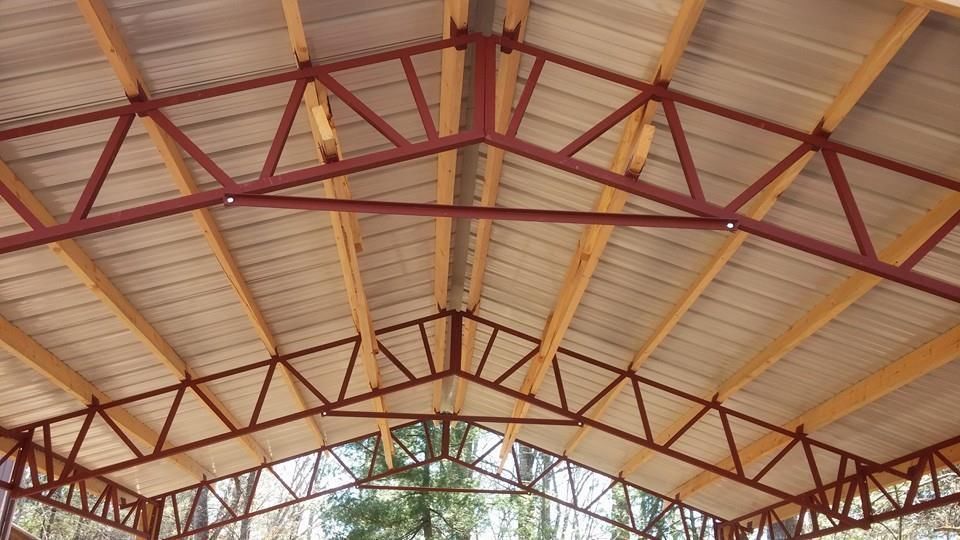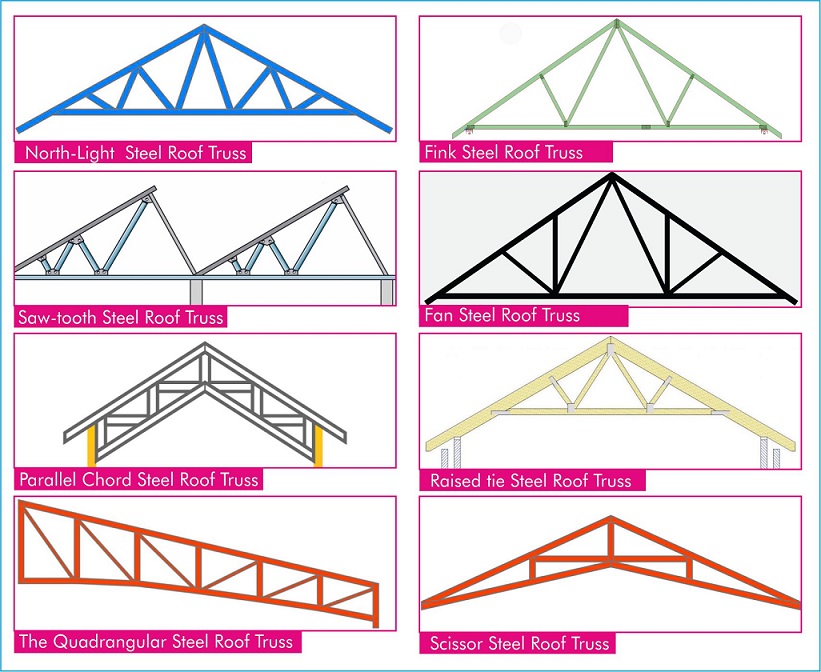A steel roof truss is a structural member element that adds strength and support to roofs. It comes in the form of a triangle unit. Each triangle unit is constructed with two top chords, a bottom chord, and webs, all connected at the ends by joints. All the joints in the truss members have pinned connections such that no shear or moment forces are transferred from member to member. Steel roof trusses main functions are to carry the roof load and to provide horizontal stability.
Components of steel roof trusses;
A roof truss consists of three main components namely, top chords, bottom chords and web bracing
- Top chord: it is an inclined or horizontal member used to create the upper perimeter of the roof to resist live load
- Bottom chord: is the bottom horizontal that carries combined stress from both tension and bending of the truss.
- Web bracing: there are members that enable the joining of bottom chords together in a triangular pattern
Manufacturing of steel roof trusses
Steel roof trusses are pre-fabricated in factories under stringent quality control. Therefore, the trusses that arrive at the job site are constructed exactly as designed, with minute variations. They are fitted according to all of the necessary design choices and modifications. After being manufactured in factory-controlled environments and are delivered on-site in semi-assembled form, where final installation takes place

Advantages of steel roof trusses
A lightweight steel roof truss does not provide too much of a strain on elements such as walls, ceilings etc. These are used in a wide range of industrial and commercial buildings. They are the most suitable solutions for construction projects that require long spans and flexible space. Its applications include factories, airport terminals, aircraft hangers, sports stadiums, auditoriums etc.
- Lightweight and durable
- Supports and strengthens the roof framework
- Efficient in resisting external loads as the cross section of all the members is uniformly stressed
- Provides energy efficiency
- Maintains a high strength-to-weight ratio
- Reduce/prevent condensation and occurrence of mold
- Prevents damage to an exposed roof
- Offers cover and protection from outdoor elements
- Prevents UV radiation
- Fabricated under a controlled environment
- Help to improve the aesthetics of a building structure.
- Withstands natural calamities because of their sturdy construction
- It can also be used to support storage
- Easy and quick to erect
- High resistance to adverse weather conditions,
- During manufacturing, additional protective and anti-corrosive coatings are added
- Fire-resistant
- Supports long span
- Reduced deflection
- Support considerable loads.
Because of its functionality and advantages a roof truss is essential to the integrity of the building roof system.
Different types of roof steel trusses
Pratt Steel Roof Truss
Pratt trusses are used in long-span buildings ranging from 20 to 100 m in span. It includes vertical and diagonal members. These types of trusses can cover lengths ranging between 6-10 metres.
Warren Steel Roof Truss
Warren trusses are positioned alternatively to create a shape of ‘W.’ They have equal compression and fewer external components. They can be used in buildings that cover 20 to 100 metres spans.
Fink Steel Roof Truss
Fink truss comprises small members and chords. The fink truss can also be used to support other trusses by doubling or tripling the number of plies. With a large variety of spans up to 14 metres and pitch ranges from 10° to 60°. These types of steel trusses can be used in places with shorter spans.

King Post Steel Roof Truss
King post trusses are manufactured with a combination of wood and steel. It comprises two-angle support members. They are used for a short span of around 8 metres and are ideal for small houses.
Queen Post Steel Roof Truss
The queen post truss is also simple to fabricate but very versatile in use. It has two vertical posts rather than one. The tops of the queen truss are connected by a straining beam. It can be used for a span of 10 metres. They are used in domestic-type structures in form of extensions.
Howe Steel Roof Truss
Howe truss is manufactured with a combination of wood and steel. The use of steel provides extra support as they have a wide span that can cover around 6 to 30 metres.
North-Light Steel Roof Truss
North light truss is used in industrial buildings. They allow natural lighting through the use of glazing. It is used in large spaces and allows maximum light to reach the space. These are found in industrial buildings with a span of 20-30 metres.
Fink Steel Roof Truss
Fink truss consists of an internal web shaped like a W to give the ultimate strength to the material ratio for spans It is suitable for spans up to 9 metres.
Saw-tooth Steel Roof Truss
A saw-tooth truss comprises a series of ridges with dual pitches on either side. It is used in multi-bay buildings.
Fan Steel Roof Truss
A fan truss is a type of steel roof truss in which the top chords of the truss are divided into smaller lengths. Its span can reach from 10-15 yards. They are used in commercial projects and large domestic dwellings.

Parallel Chord Steel Roof Truss
Parallel Chord Roof Truss is constructed by placing two chords running parallel to each other. These chords are further supported by reinforcing trusses in between the top and bottom chords.
Raised tie Steel Roof Truss
A raised tie roof truss is used to provide a higher ceiling line. This type of truss is used to increase the height of a room of a building. It can be used to provide a sloping ceiling effect.
The quadrangular Steel Roof Truss
Quadrangular roof trusses have parallel chords and web members. It is used in auditoriums or railway sheds.
Scissor Roof Truss
A scissor truss has sloped bottom chords that are inverted-V shape. It accommodates a vaulted ceiling in a similar period as standard trusses. In this type of truss, the sloping ceiling is at a shallower angle to the outer roof pitch.
Conclusion
Discussed above are the advantages and types of steel roof trusses. In an upcoming article we will discuss each of the steel roof truss types in details.

